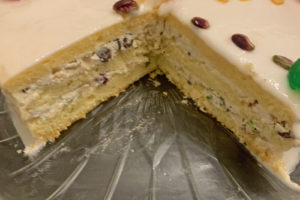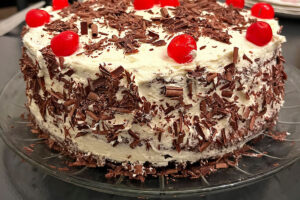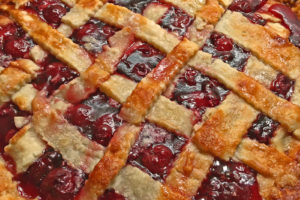With the holidays approaching, it’s time to begin considering what cookies you will bake. I highly recommend two Sicilian specialties that will both surprise and delight your guests. As a child, each year I looked forward to my Nonna’s preparations for the holidays. These two special cookies, in particular, held me spellbound: a chocolate-spice cookie, sometimes called, tatù; and the reigning queen of all holiday cookies, the cuccidati, a fig-filled confection.
A variety of recipes abound on the internet for both cookies, but I note that versions I inherited from my Nonna differ somewhat from those that are available. Surely, everyone believes that his or her family’s version is the definitive one, but I suspect we just love best what we grew up with. People are the most adamantly defensive over the cuccidati recipes, and I am no exception.
Interestingly, my family’s recipes for both cookies use a simpler and smaller list of ingredients than those available on the internet. I’ve sampled cuccidati from the finest Italian pastry shops in both New York and Sicily, but I am still committed to my Nonna’s version. I often have to fight the urge to tell the owners of these shops that they need to check out our recipe.
What I particularly like about this version is its clean flavor. Many recipes call for dates, chocolate chips, a melange of spices, Marsala, and a plethora of other ingredients, many of which I have tried myself. In my opinion all these superfluous additions cancel each other out by providing no discernible or distinctive flavor. On the other hand, my grandma’s version makes the fig the starring ingredient, with a pungent undercurrent of tangerine in the supporting role.
In fact, I’ve found no other recipe that uses the more assertive tangerine rather than the more usual orange peel. Also, this recipe calls for a dusting of powered sugar rather than the icing and colored sprinkles generally used. This gives the cookies a more sophisticated appearance. Some women I knew as a child were able to cut and shape the cuccidati into the most beautiful florid designs. I don’t have this ability, so my version is quite plain.
The simplicity of ingredients in these cookies may be the result that my grandparents came from very poor families and simply couldn’t afford all the elaborate additions. On the other hand, I suspect that our recipe mirrors more closely its obvious Arabic roots, with its combination of figs, nuts, and honey. Both recipes are large. They both take a bit of effort so it seems foolish to make small amounts. The cookies make wonderful homemade holiday gifts, and both are good keepers. They can be held for a week or two in an airtight tin or last for months in a freezer. If you wish, you can cut each recipe in half or thirds.
Cuccidati
Begin by making the pastry. Whisk together 3 pounds flour, 1 1/4 cups sugar, 2 tablespoons baking powder, and 3/4 teaspoon salt in a very large bowl. With a pastry blender, work in 6 ounces each of butter and lard (or vegetable shortening) until the mixture forms coarse crumbs. I use the pastry blender with my right hand and work the dough between my fingertips with my left hand.
Beat 6 eggs with 1 1/2 cups milk and 2 teaspoons vanilla. Using a large wooden spoon, combine the liquid with the dry ingredients until it forms a ball. I also use my hands to gently kneed and shape the ball. Place the ball in a large plastic bag and refrigerate for several hours or overnight. This makes rolling the pastry much easier.
In a bowl, combine and mix 3 pounds stemmed dried figs, 4.5 ounces raisins, 3/4 pound walnuts, and 3 tangerine peels (no need to remove the pith), torn into small pieces. Take a handful of the mixed ingredients and pass them through the fine blade of a food grinder, continuing until you use all the mixture. Do not try to grind the ingredients separately because they are very hard to combine once ground.
My grandmother used a hand grinder for this job, but it’s a lot of work. Many recipes use a food processor, but I can’t vouch for this method, never having tried it. I have a small, home electric grinder for the purpose.
Add 1 1/4 cups honey to the ground mixture. Moisten with a little bit of warm water.
Cut off ⅓ of the pastry and return the remaining portion to the refrigerator. Roll out the dough on floured surface with a floured rolling pin. Roll out a rectangle about 2-feet long by 8-inches wide, until you achieve a thin pastry (much like pie crust) that is less than 1/8-inch thick.
With your hands roll the filling into a 1-inch-diameter sausage shape, and lay it lengthwise onto the pastry sheet about an inch from the front edge. This can be done in sections attaching one piece of filling to the next with your hands.

Placing the fig roll onto the rolled pastry.
![]()
![]()
Roll the front edge of the pastry over the filling.

Rolling the pastry over the fig filling.
![]()
Cut the pastry lengthwise, leaving enough of an edge on the far side of the filling to cover the whole roll. Pinch the edges of the pastry end together to seal the roll. With the palms of your hands, roll the entire sausage shape on the cutting board to create a nice even log.

Slicing off the rolled log.
Cut the log into about 3-inch lengths.

Cutting into 3-inch lengths.
Take each 3-inch length and gently pull it with your hands to elongate slightly. This is done because the pastry tends to thicken as it sits, and you want it to remain as thin as possible. If necessary, roll the cut piece with the palms of your hands on the floured board to create a smooth well-shaped roll.
With the seam side down, cut slits on one side of the cuccidati at about 1/4-inch intervals.

Slitting the cookies.
Bend each cookie into a crescent or half-moon shape and place on a heavy, ungreased baking sheet.

Twisting into crescents.
You should be able to get 2 to 3 rolls from the rolled-out pastry. Cut the remaining refrigerated pastry in half and proceed in the same way, until you’ve used all the pastry and filling. If you have extra pastry and not enough filling, wrap and freeze the remaining pastry for another use.

Finished powder sugared cuccidati.
Bake the cookies on the bottom shelf of a preheated 350° oven for 8-10 minutes. Move the sheet to a high-level rack and bake about 5-7 minutes longer. The tops of the cookies should be a very light brown color. Remove the cookies to a rack and allow to cool. When fully cooled, dust heavily with powdered sugar. Makes about 72 cookies.
To print or download recipe, click here.
Chocolate Spice Cookies
These cookies have a wonderful taste of chocolate, cloves, orange, and liquer.
In a very large bowl, combine 3 pounds flour, 1 1/3 pounds sugar, 5 ounces sifted cocoa, 3 1/2 tablespoons baking powder, 1 tablespoon of cloves, and pinch ofsalt. Whisk together gently until well mixed. Work in 1/2 pound each of butter and vegetable shortening with a pastry blender and the fingers of your hand, until coarse crumbs are formed. Stir in 3/4 pound of chopped walnuts.
Beat 6 eggs well, then beat in 1 pint of milk, the juice and grated rind of large orange, and 1/4 cup liqueur. Pour the liquid into the dry ingredients, and combine with a heavy wooden or metal spoon or heavy rubber spatula, until a smooth ball is formed. The dough will be extremely sticky. Refrigerate for at least 1 hour or longer until you can work the dough with your hands without sticking.
Roll the dough in the palm of your hands to form a smooth ball about the size of an unshelled walnut. Place the balls on an ungreased baking sheet. I find that I need to rechill the dough about halfway through the rolling process because it starts sticking to my hands.

Rolling the dough into balls.
Bake on the bottom shelf of a 350° preheated oven for about 10-12 minutes. Some people prefer these cookies hard all the way through. I like them with a hard exterior and a softer center. You may have to experiment by testing the first batch to see which you prefer (a hard exterior forms only after the cookies have cooled).

The baked cookies.
When done remove to a rack to cool. When the cookies are thoroughly cooled, prepare the icing, which is essential because the cookies are too bitter without it. Sift 1 box powdered sugar into a shallow bowl. Add enough hot, scalded milk to create a thick smooth glaze. Add vanilla. Dip the tops of each cookie into the glaze until well coated.

The glazed cookies.
Place a wire rack on top of some waxed paper to catch the drippings, then place the glazed cookies on the rack to dry thoroughly. It’s very important to allow the cookies to dry for several hours before storing them in a closed container. If they are stored before fully dry, they will begin to sweat and then mold in a couple days. Makes about 120 cookies.




